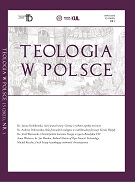Streszczenie
MISYJNA NATURA KOŚCIOŁA JAKO FUNKCJA SOTERIOLOGICZNA W ŚWIETLE DOKUMENTÓW SOBORU WATYKAŃSKIEGO II
Sobór Watykański II w konstytucji Lumen gentium ukazuje misterium Kościoła w relacji do Najświętszej Trójcy. Ukazując w perspektywie owoc miłości, który jednoczy Ojca z Synem w łonie Trójcy, gdzie właśnie siłą tej miłości Ojciec zechciał zjednoczyć całe stworzenie w swoim Synu. Zatem gdzie Mysterium Ecclesiae wypływa z Mysterium Trinitatis. Ponadto w dekrecie o działalności misyjnej Kościoła pojawia się defi nicja, że: „Kościół pielgrzymujący jest misyjny ze swej natury, ponieważ swój początek bierze wedle planu Ojca z posłania (ex missione) Syna i z posłania Ducha Świętego. Plan ten zaś wypływa ze źródła miłości, czyli z miłości Boga Ojca” (n. 2). Tym twierdzeniem Sobór zdefi niował istotę misyjnego wymiaru Kościoła, i potwierdził, że głoszenie Ewangelii każdemu człowiekowi jest podstawowym zadaniem Kościoła – zbawieniem.
Summary
THE MISSIONARY NATURE OF THE CHURCH AS A SALVIFIC ROLE IN THE LIGHT OF THE SECOND VATICAN COUNCIL DOCUMENTS
The Second Vatican Council in the Constitution Lumen gentium shows the mystery of the Church in relation to the Holy Trinity. In the perspective as the fruit of love which unites the Father with the Son within the Trinity: just on the strength of this love the Father wanted to unite all creation in his Son. Mysterium Ecclesiae arises therefore Mysterium Trinitatis by. Also in the Decree on the Missionary Activity of the Church defi ned it: ”The Church is missionary by nature since its origin in the mission of the Son and of the Holy Spirit, according to the plan of God the Father” (AG 2). With this statement the Council has identifi ed in its essence the missionary dimension of the Church, and it reaffi rmed that the preaching of the Gospel to all men is the main task of the Church – salvation.
Ostatnia aktualizacja: 25.01.2016, godz. 19:53 - Natalia Haniewska































